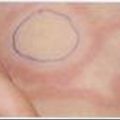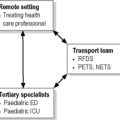6.6 Bronchiolitis
Introduction
Epidemiology
Bronchiolitis is a common presentation to emergency departments, with a seasonal pattern. It typically affects children under the age of 12 months, but may occur in children up to 2 years of age. The peak age is between 2 and 8 months of age, with males more commonly affected. Approximately 1% of children will require admission for bronchiolitis, which is the leading cause of admission for children with lower respiratory tract disease in the Western world.1 Epidemics of bronchiolitis occur during each winter, with the peaking of respiratory viruses. While respiratory syncytial virus (RSV) is the commonest organism responsible for bronchiolitis, others include parainfluenza virus, adenovirus, rhinovirus and influenza. Bronchiolitis may also complicate exanthems such as measles and varicella in young children. It is estimated that by the age of 2, 70% of children have been exposed to RSV. Despite the frequency, mortality is low at less than 1% of hospitalised babies. High-risk patients include those with underlying chronic lung disease, congenital heart disease, neuromuscular disorders or corrected age less than 2 months of age.1
Pathophysiology
How this clinical picture emerges is still unclear. The role of pro-inflammatory regulators interleukin (IL)-6, IL-8, interferon-γ, and macrophage inflammatory protein-1β, as well as of the regulatory cytokine IL-10 in causing the disease as we know it, as opposed to facilitating healing and repair still remains to be elucidated.2–4
Clinical assessment
History
Bronchiolitis typically presents with a prodrome of upper respiratory tract infection over 1–2 days.
Examination
Chest examination may reveal hyperinflation and recessions of the chest wall due to increased work of breathing. Paradoxically, as an infant fatigues, the recessions will decrease. In this situation the diminishing air entry signifies progressive disease. Auscultation reveals wheezes that are generally symmetrical. There may be inspiratory crepitations. The auscultation findings are dynamic as coughing will move secretions to more proximal airways, with resultant temporary clearing of the wheeze. A short time later, as the fluid returns to the more peripheral airways, the wheeze returns. Hence, babies referred by a local doctor with ‘marked wheeze’ may initially appear to be wheeze free when seen in the emergency department (ED) a short time later. Re-examination later will confirm the presence of wheeze.5
Oxygen saturations fall with disease severity and SaO2 levels below 94% indicate a need for admission.4 McIntosh graded severity of bronchiolitis by simply documenting children as needing no oxygen, requiring oxygen and needing ventilation.6 Certainly, increasing oxygen requirements will be associated with increasing severity of disease.
Assessment
Assessment of the child with bronchiolitis requires several components to be considered. Several scoring systems for bronchiolitis have been developed to determine the severity of the disease. Table 6.6.1 shows the criteria used to help determine severity and management issues.
ABG, arterial blood gas; NG, nasogastric; PICU, paediatric intensive care unit.
Differential diagnosis
The differential diagnosis of bronchiolitis includes cardiac failure, asthma and pneumonia (Table 6.6.2). Cardiac failure can present with many of the features of bronchiolitis – dyspnoea, tachypnoea, tachycardia, crepitations and palpable liver. Feeding may also be poor. However, infants with bronchiolitis will usually have the URTI prodrome and the onset of poor feeding is acute. The feeding difficulty in children with cardiac failure is less acute, leading to poor weight gains. Additional signs, such as a gallop rhythm or murmur, suggest an underlying cardiac abnormality. Recurrent episodes of wheeze associated with URTIs, particularly in older infants, can be difficult to differentiate from asthma. Pneumonia in infants can mimic bronchiolitis and the differentiation can be difficult. Some infants have persistent wheezing, which does not compromise activity or feeds and is unresponsive to inhaled bronchodilators (‘fat happy wheezer’).
Investigations
The diagnosis of bronchiolitis is clinical, based on history and examination. The role of chest radiography is limited and only indicated if the diagnosis is unclear or in severe cases. The typical radiological findings are hyperinflation of the lung fields, with bilateral increase in interstitial markings (particularly perihilar regions). There may be patchy atelectasis secondary to plugging or, in severe cases, collapse. Children with high fever, or a clinical impression of sepsis, may have superimposed bacterial infection, and a chest X-ray will aid exclusion of this diagnosis.7
Nosocomial infection and cross-infection can occur during bronchiolitis outbreaks. In patients being admitted to hospital, a nasopharyngeal aspirate (NPA) or posterior nasal aspirate (PNA) can be done to analyse for RSV or other respiratory viruses for isolation control. The development of near patient testing (NPT) kits for rapid diagnosis of RSV infection has aided infection control in some areas.8 The rapid testing for RSV may be useful in cases of neonates to help with decision making where a child presents with fever, collapse or apnoea.
Treatment
Drug therapy
The role of various drug therapies in bronchiolitis is controversial and still undergoing research.
Two meta-analyses of the benefits of inhaled β agonists in bronchiolitis have proved inconclusive. A more recent Cochrane Review suggests some minimal benefit, while Patel has recently shown no benefit with albuterol (salbutamol).9–12 Nebulised adrenaline (epinephrine) has similarly not been shown to provide benefit over a sustained timeframe. Isaacs suggested that if wheeze is the predominant sign then a trial of selective β agonist may help.1
Systemic or inhaled glucocorticoids are widely used in some parts of the world, but the evidence for their use is variable. A recent meta-analysis has shown some marginal benefit with systemic glucocorticoid use.13 The role of ipratropium bromide is equally unclear and there is no clear-cut benefit to use.14
Nebulised adrenaline (epinephrine) and dexamethasone in combination have been shown in a multicentre trial in Canada to have some potential beneficial effect on the severity of the illness as determined by hospital admission.15
Ribavarin and antiviral immunoglobulins are not used in the ED setting, but may have a role in high-risk groups in intensive care. Ribavirin is expensive and has only marginal benefit when given aerolysed to high-risk patients with severe disease.16 The role of immunisation against RSV is still under investigation.
1 Isaacs D. Bronchiolitis. Br Med J. 1995;310(6971):4-5.
2 Bont L., Heijnen C.J., Kavelaars A., et al. Peripheral blood cytokine responses and disease severity in respiratory syncytial virus bronchiolitis. Eur Respir J. 1999;14(1):144-149.
3 Smyth R.L., Mobbs K.J., O’Hea U., et al. Respiratory syncytial virus bronchiolitis: Disease severity, interleukin-8, and virus genotype. Pediatr Pulmonol. 2002;33(5):339-346.
4 Bennett B.L., Garafolo R.P., Cron S.G., et al. Immunopathogenesis of respiratory syncytial virus bronchiolitis. J Infect Dis. 2007;195(10):1532-1540.
5 Mulholland E.K., Olinsky A., Shann F.A. Clinical findings and severity of acute bronchiolitis. Lancet. 1990;335(8700):1259-1261.
6 McIntosh E.D., De Silva L.M., Oates R.K. Clinical severity of respiratory syncytial virus group A and B infection in Sydney, Australia. Pediatr Infect Dis J. 1993;12(10):815-819.
7 El-Radhi A.S., Barry W., Patel S. Association of fever and severe clinical course in bronchiolitis. Arch Dis Child. 1999;81(3):231-234.
8 Mackenzie A., Hallam N., Mitchell E., Beattie T. Near patient testing for respiratory syncytial virus in paediatric accident and emergency: Prospective pilot study. Br Med J. 1999;319(7205):289-290.
9 Kellner J.D., Ohlsson A., Gadomski A.M., Wang E.E. Efficacy of bronchodilator therapy in bronchiolitis. A meta-analysis. Arch Pediatr Adolesc Med. 1996;1150(11):1166-1172.
10 Flores G., Horwitz R.I. Efficacy of β2-agonists in bronchiolitis: A reappraisal and meta-analysis. Paediatrics. 1997;100(2 Pt 1):233-239.
11 Kellner J.D., Ohlsson A., Gadomski A.M., Wang E.E. Bronchodilators for bronchiolitis. Cochrane Database Syst Rev. 2, 2000. CD001266
12 Patel H., Platt R.W., Pekeles G.S., Ducharme F.M. A randomized, controlled trial of the effectiveness of nebulized therapy with epinephrine compared with albuterol and saline in infants hospitalized for acute viral bronchiolitis. J Pediatr. 2002;141(6):818-824.
13 Garrison M.M., Christakis D.A., Harvey E., et al. Systemic corticosteroids in infant bronchiolitis: A metaanalysis. Pediatrics. 2000;105(4):E44.
14 Everard M.L., Bara A., Kurian M., et al. Anticholinergic drugs for wheeze in children under the age of two years. Cochrane Database Syst Rev. 1, 2002. CD001279
15 Plint A., Johnson D., Patel H., et al. Epinephrine and dexamethasone in children with bronchiolitis. N Engl J Med. 2009;360(20):2079-2089.
16 Everard M.L., Swarbrick A., Rigby A.S., Milner A.D. The effect of ribavirin to treat previously healthy infants admitted with acute bronchiolitis on acute and chronic respiratory morbidity. Respir Med. 2001;95(4):275-280.




